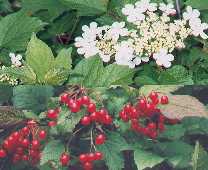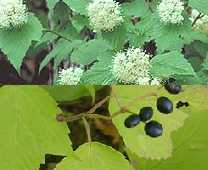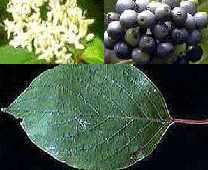|
|
|
| Caprifoliaceae |
|---|
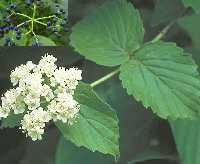
| |
Viburnum dentatum
Arrowwood:
Arrow-straight stems; uncommon but widely cultivated.
Lower leaf surface dull green, tufts of hair in vein axils or on veins.
Unfragrant white flowers, yellow stamens.
Blue-black drupes.
var. lucidum is called
V. recognitum,
Smooth Arrowwood.
|
|
| Caprifoliaceae |
|---|
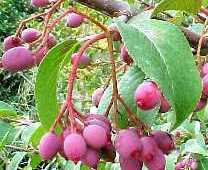
| |
Viburnum prunifolium
Black Haw:
Finely serrate leaves with dull upper side turn deep, dull red; good to excellent fall color.
Edible fruits pink turn dark blue.
Dark brown bark broken in square plates, like alligator hide.
Branches opposite and right-angled, look like fish skeleton.
Resembles hawthorns (red haws)?
|
|
| Caprifoliaceae |
|---|
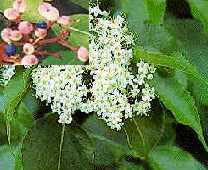
| |
Viburnum lentago
Nannyberry:
Drupes in clusters hang from pink-red petioles turn from yellow to blue-black, often persist into winter.
Similar to
V. prunifolium but
petiole has wavy margins, long-pointed leaves,
average to poor mixed fall color,
more susceptible to powdery mildew.
Nanny goats feed on berries.
|
|
| Rosaceae |
|---|
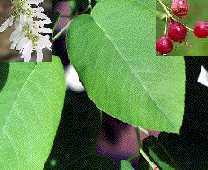
| |
Amelanchier arborea
Serviceberry:
Leaves alternate, finely serrate, and oval or oblong shaped; deep, dull red Fall color.
Slender twigs have long-pointed, yellowish buds.
Smooth, dark ashy gray and matted bark become rough with long splits and furrows.
Edible pink fruits turn purple.
|
|
| Cornaceae |
|---|
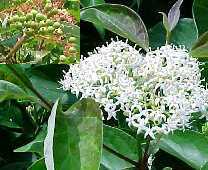
| |
Cornus racemosa
Gray Dogwood:
Elliptic to lance-shaped leaves turn dusky purplish red.
White flowers with 4 petals in terminal racemes turn to white drupes.
Terminal stems holding the flowers are red;
red stem color often persists into early winter.
Suckers from stolons.
|
|
|
| Rosaceae |
|---|
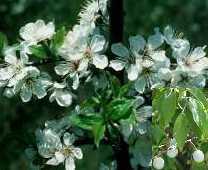
| |
Prunus americana
Wild Plum:
Finely serrated leaf 3-4 inches, pointed tip, green above, paler beneath.
Reddish twig some thorns, developing exfoliating gray film; leaf scars raised.
White flowers 5 petals, 1 inch across, protruding yellow anthers, unpleasantly aromatic.
|
|
